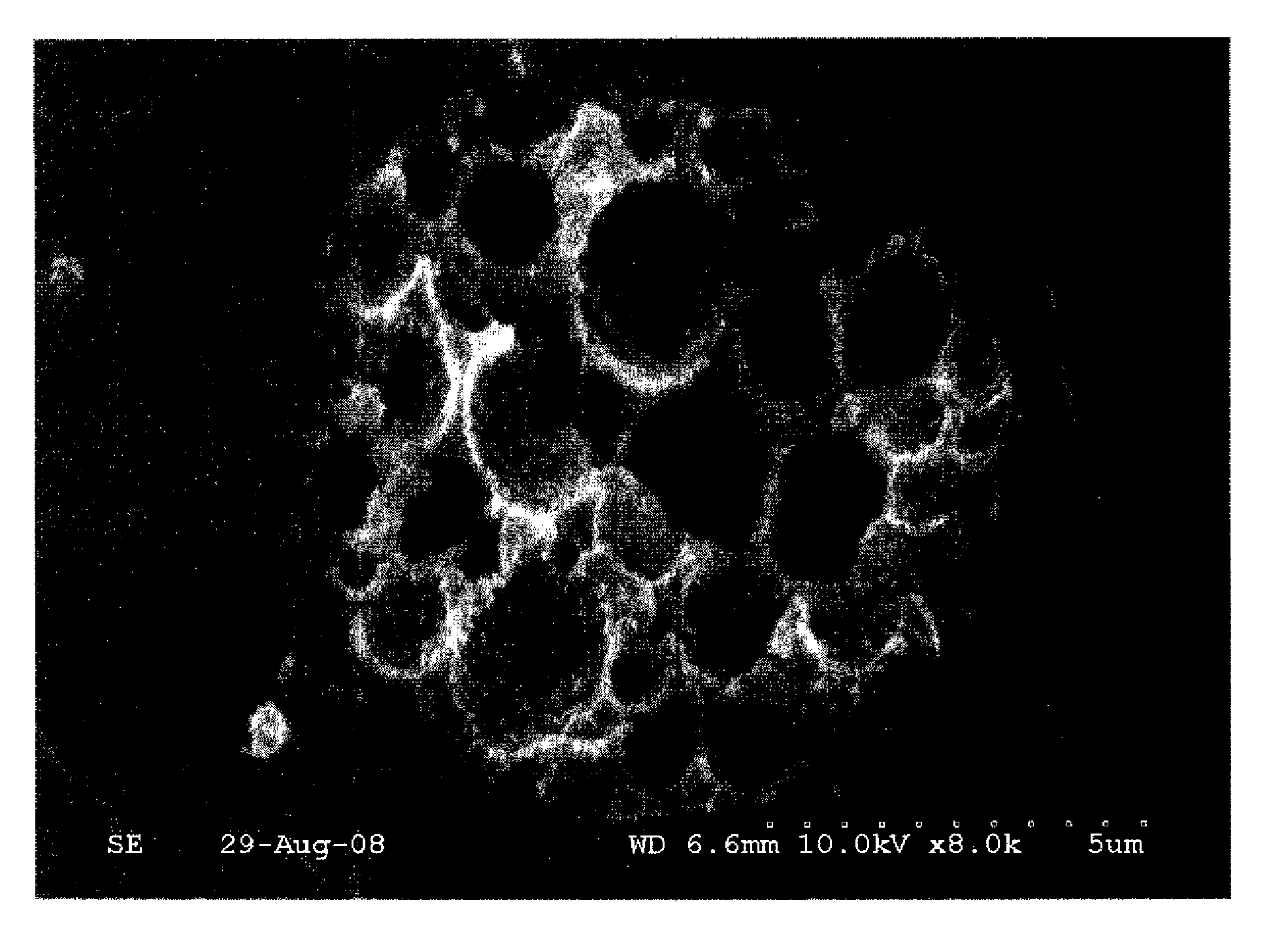Polymer particles with additives encapsulated in microvoids
a technology of additives and polymer particles, applied in the field of new porous particles, can solve the problems of incorrect amount of marking particles being deposited, affecting transfer and development, or both
- Summary
- Abstract
- Description
- Claims
- Application Information
AI Technical Summary
Problems solved by technology
Method used
Image
Examples
example 1 (
Invention)
Carbon Black in Pores
[0089]A 5 wt % solution of CMC molecular weight 250K, 48.58 grams, was added to 26.91 grams of Sensjet 2000(14.5 wt %) along with 37.01 grams distilled water. This was dispersed in 242.9 grams of a 20 weight % solution of Kao E polymer resin in ethyl acetate for two minutes at 6800 RPM using a Silverson L4R homogenizer. The resultant water-in-oil emulsion was further homogenized using a Microfluidizer Model #110T from Microfluidics at a pressure of 8900 psi. A 229 g aliquot of the resultant very fine water-in-oil emulsion was dispersed, using the Silverson homogenizer again for two minutes at 2800 RPM, in 375 grams of the second water phase comprising a 300 mM pH 4 citrate-phosphate buffer and 16.8 grams of NALCO 1060™, followed by homogenization in a orifice homogenizer at 1000 psi to form a water-in-oil-in-water double emulsion. The ethyl acetate was evaporated using a Heidolph Laborata rotary evaporator at 40° C. under reduced pressure. The resultin...
example 2 (
Invention)
Carbon Black in Pores
[0090]Example 2 was made as in Example 1 except that 30 g of a 5 weight % CMC was used in the first water phase along with 10.7 g water and 42.6 g of Sensjet 1000 (14.1 wt %). The oil phase contained 34.4 g ethyl acetate and 215.6 g of a 20.4 wt % solution of Kao N in ethyl acetate. An aliquot of 288.5 g of the water in oil emulsion was dispersed in 482.2 g of the buffer and 26.8 g Nalco 1060. Prior to evaporation the emulsion was diluted 1:1 with a 0.03 wt % poly(ethyl oxazoline) solution in water.
[0091]The particle size of the resultant nonspherical, 12 wt % carbon black containing particles, was 6.6 microns and the porosity was 50%. The charge, Q / S measured at 2 and 10 minutes were −11 and −35 μC / m2 respectively. This shows that the charge of the bare toner was good. CP was good at 320 cm2 / g2 and demonstrated that isolation of carbon in the pores did not significantly affect the tinctorial strength.
example 4 (
Inventive)
Cyan Pigment in Pores
[0094]A porous toner containing cyan pigment in the pores was made using a procedure similar to the one in Example 1 except that a water dispersed cyan PB15:4 Cabojet 250C (10% solids) was used in place of the Sensijet in Example 1. The first water phase contained 174.4 g of pigment dispersion, 116.6 g of 5% CMC and 151.7 g of distilled water. The oil phase used was 971.5 g. A 915 g aliquot of the emulsion was added to 1500 g of buffer containing 85 g Nalco 1060. Prior to evaporation of the solvent, a 1:1 dilution of the emulsion was performed with a 0.03 wt % solution of poly(ethyl oxazoline) in water. The resultant 6.4 micron nonspherical particles containing 9 wt % pigment had a porosity of 50% and the charge, Q / S measured at 2 and 10 minutes were −23 and −42 μC / m2, demonstrating good charge and porosity with pigment located in the pores. FIG. 3 is an SEM image of a freeze fractured particle of Example 4 and shows the pigment contained in the pores ...
PUM
| Property | Measurement | Unit |
|---|---|---|
| porosity | aaaaa | aaaaa |
| porosity | aaaaa | aaaaa |
| viscosity | aaaaa | aaaaa |
Abstract
Description
Claims
Application Information
 Login to View More
Login to View More - R&D
- Intellectual Property
- Life Sciences
- Materials
- Tech Scout
- Unparalleled Data Quality
- Higher Quality Content
- 60% Fewer Hallucinations
Browse by: Latest US Patents, China's latest patents, Technical Efficacy Thesaurus, Application Domain, Technology Topic, Popular Technical Reports.
© 2025 PatSnap. All rights reserved.Legal|Privacy policy|Modern Slavery Act Transparency Statement|Sitemap|About US| Contact US: help@patsnap.com



